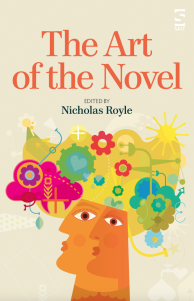
I had a hard time deciding which should be my last post of the year. Finally, I chose to write about The Art of the Novel, a book I devoured and will return to very often. It may sound like The Art of the Novel is only for writers but that’s not the case. Readers, writers, and teachers of creative writing will find it equally inspiring and useful.
Editor Nicholas Royle has asked eighteen writers to write an essay about an aspect of the novel or a theme related to novels. Additionally they were to share one of their favorite writing exercises, a list of top tips, and a list of novels. Some of these book lists reflect the topic the authors have written about, but more often, they are just a list of the writer’s favorite novels.
Every one of these nineteen articles (Royle wrote one too) was interesting. Sometimes the authors used other writer’s novels to talk about a topic, sometimes they used a book they had written to show the reader how they achieved something. The topics are wide-ranging: Magical Realism, Narrative Perspective, Motivation, Historical Novels, so-called “Dos and Don’ts”, Place, Plot Twists . . . I can’t think of an aspect that hasn’t been covered. Unless you write/read exclusively in a specific genre, you’ll find something of interest in this book.
These are some of the authors who have contributed: Jenn Ashworth, Stella Duffy, Alison Moore, Nikesh Shukla, Kerry Hudson, Joe Stretch, Toby Litt, Alice Thompson and many more.
To give you an idea of what to expect, I’m picking one essay, Kerry Hudson’s “Details, Details”.
At first, Kerry Hudson asks the reader to imagine a man and a woman having dinner and arguing about something. Eventually, they come to a conclusion and smile at each other. Obviously, this isn’t much of a scene, so paragraph by paragraph, she fleshes it out and shows the reader what can be gained by adding details. She then goes one step further and asks the reader to describe the present moment. Where is he/she reading? What does the environment look, smell, sound like?
The essay is followed by a “proper” writing exercise. She asks the reader to leave the house and sit somewhere outside, taking notes of as many details as he/she possibly can. Afterwards, writers should then weave these descriptions into an existing draft and make connections.
As I mentioned before, every exercise is followed by top tips. In this case they are as follows:
- Get your arse on the seat; writers write.
- Write your shitty first draft solely for yourself. Edit and revise for your readers.
- Be kind. Work hard. Don’t be an arsehole.
The last element of the article is her list of favourite/recommended novels.
Hudson’s essay is a bit different as it focuses heavily on exercises. Other’s like Livi Michael’s “Approaches to the Historical Novel” focus on other writer’s work and on showing different ways to write historical novels. Alison Moore’s “Living in a Real World” draws heavily from her prize-winning novel The Lighthouse.
What I enjoyed a great deal was how different all of these authors sounded. Their voices, tones, approaches are so varied that it never gets boring. Reading this, you have a feeling of listening to many, very different, people telling you something about books.
The exercises and top tips are as varied as the voices, which makes them very useful for all sorts of writers, whether they are beginners or more advanced, more interested in genre or drawn to literary fiction.
Since there are nineteen writers in this book, and they all recommend ten to fifteen books, you get a huge list of recommendations. Quite a few books and novelists are mentioned by several authors, but none as often as Muriel Spark’s The Driver’s Seat.
Whether you are a writer or a reader, I highly recommend this book. It will give you food for thought, inspiring exercises, tips and many (themed) book recommendations.
